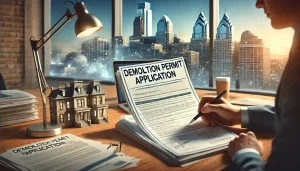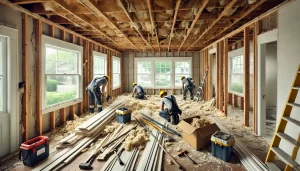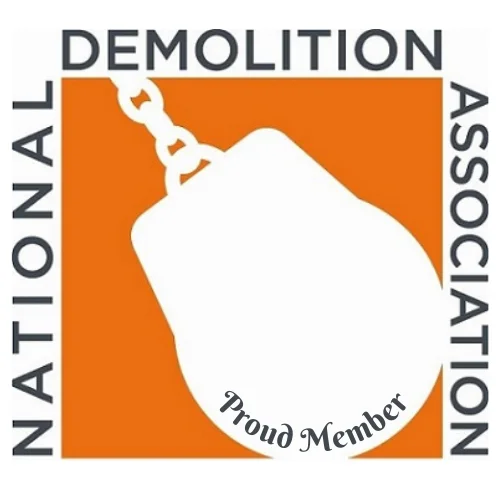Constructing a building is complicated, but there’s a notion that demolishing one is much easier. All you need to do is grab some sledgehammers and/or a wrecking ball and start swinging—right?
We understand where this idea comes from, but it couldn’t be further from the truth. There are a variety of different demolition methods, and each of them is carefully calculated and planned based on the type of structure being demolished, its surroundings, and other factors.
Let’s dispel the notion that demolition is simple by looking at the three most common demolition methods—explosive and implosive, machine demolition, and demolition by hand. Along the way, we’ll discuss the different circumstances in which each method is used. There’s a lot to break down, so let’s get started!
Explosive Demolition
Explosive demolition (sometimes called implosive demolition for reasons you’ll soon learn) is the most visually stunning and sudden type of demolition.
Technicians will place explosives on key locations in the building, usually in the basement and on the lowest floors. The explosive charges are then detonated in sequence in order to trigger a structural collapse. When the building is triggered to collapse on itself, it’s called implosion demolition. Other times, the building may be made to collapse onto its side—though this only occurs if there’s sufficient space around the building.
Explosives are typically used when a building is quite tall (usually over 65 feet)—buildings at this height are difficult to demolish using more conventional means without serious time and cost constraints, not to mention health and safety risks. Skyscrapers are often destroyed using explosive demolition.
Surprisingly, explosive demolition is often one of the safest methods of demolishing large buildings—it’s also by far the fastest. The main disadvantage of this method is its cost—careful planning is required, and the explosives and staff needed to set and detonate them don’t come cheaply.
Explosive demolition isn’t suitable for all frame types—steel frames shouldn’t be demolished with explosives. It’s hard to beat explosive demolition when you need a tall building knocked down quickly and safely. This option is perfect if a new structure needs to be built on the spot in short order.
Machine Demolition Methods
Several different machines are used to demolish buildings—hydraulic excavators, wrecking balls, bulldozers, and more.
Generally, machine demolition is used on medium to large buildings that cannot be demolished using explosives due to their construction, health and safety hazards, or cost restraints. Given the versatility of the machines available, this is one of the most common commercial demolition methods.
Wrecking Ball
Wrecking balls are probably what you imagine when you think of machine demolition—you might be surprised to learn that they’ve fallen out of favor. Today, high-reach excavators (which we’ll discuss in the next section) are used much more frequently.
The problem with wrecking balls is that they’re unpredictable—they swing in a pendulum that’s impossible to fully control, which can lead to collateral damage. They also cause dust, debris, and other contaminants to go flying in the air. They’re still used at times, however, especially when demolishing large brick or concrete structures; the weight of the wrecking ball is exceptional at destroying masonry.
High-Reach Excavators
High-reach excavators are the gold standard for modern machine demolition. A hydraulic excavator is fitted with a high-reach arm, and using a combination of pushing, pulling, and impact, the excavator dismantles the building from top to bottom, reducing the risk of collateral damage.
This method of demolition is incredibly precise and safe; it’s the most efficient method of machine demolition. Excavators are commonly used in tight spaces and densely populated urban areas, where there’s a real risk when dust and debris are launched into the air.
The main disadvantage to this method of demolition is that it takes longer than explosive demolition and tends to cost more than manual demolition.
Demolition By Hand
Demolition by hand, known as manual demolition, is the oldest method of demolition. You’ll see it used when hazardous materials need to be removed before large-scale machine demolition or on smaller structures.
Manual demolition is also the most versatile demolition method available. Demolition experts will use various tools, from sledgehammers to saws, to demolish the building from top to bottom. Machines like bulldozers and excavators are also frequently used in tandem with manual demolition tools; this helps the demolition experts clear large pieces of debris more quickly.
Deconstruction is one type of manual demolition; it’s the most environmentally friendly form of demolition, as windows, doors, and other reusable components are taken apart and recycled rather than destroyed.
Use manual demolition when you’ve got a smaller building, if there are health and safety concerns, if you’re looking to recycle, or when handling hazardous materials like asbestos.
Factors That Could Impact the Demolition Process
There are a number of different factors that might affect which demolition process you choose, including:
- Your budget
- The size of the building being demolished
- The materials the building was constructed from
- The area surrounding the building being demolished
- Local by-laws
- Whether or not hazardous materials are present
- Green incentives
- And more
The best method to use for your demolition plan will vary based on these and several other factors. Talking to experts in the demolition industry can help you choose the best demolition method for your project.
Choosing the Right Demolition Method for Your Project
There’s no real way for a layperson to guess the right demolition method for their project—there are simply too many different factors to consider (or even to list here). A very tall building may still require a combination of different demolition techniques to be demolished safely, and a small building may still benefit from machine demolition.
By sharing the details of your project with your demolition team—everything from the blueprints for the building to your timeline—you’ll be able to create a plan that combines any of the demolition methods listed above to safely and efficiently demolish your edifice.
If You Want Your Demolition Projects To Be Hassle-Free, Contact Bella Contracting
Who doesn’t want a hassle-free project? We have over two decades of experience handling demolition projects throughout the United States. Our heavy demolition company has access to all the explosives, machinery, and experts you need to complete any demolition project. Call us today—no hassle, just expert demolition services.










